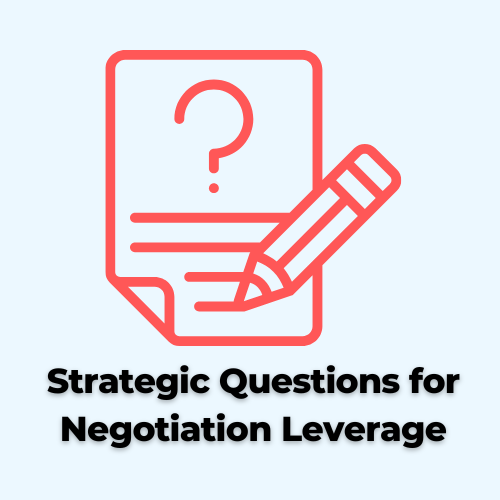Executive Salary Negotiation: How to Negotiate an Executive Job Offer
If you’ve recently received a job offer at the executive level, you’re in the right place. Working as an executive can be a huge step forward in your career journey, and you want to make sure you make the most of it—and that includes making the most of your executive compensation package.
As you know, executives are responsible for strategically leading, guiding, and overseeing the companies they work for. Regardless of the field you’re in, your role as an executive is a critical one, and your compensation should reflect that.
Even if you’ve never negotiated a job offer before, a successful executive salary negotiation is not far out of reach. In this article, we are going to share with you our strategies for navigating every step of the executive salary negotiation process. Whether you’re looking to negotiate a tech executive salary, executive officer salary, chief executive salary, or an executive level role in a specific department (i.e., executive project management salary), our step-by-step executive salary negotiation tips will prepare you to approach your executive compensation negotiation with confidence.
Want to Negotiate Your Offer? Get offer-specific guidance from a Salary Negotiation Coach. We help executives negotiate competitive job offers.
Or leverage our Salary Negotiation Courses and Salary Negotiation Templates.
 Job Offer Negotiation Course
Job Offer Negotiation Course
- Get our job offer negotiation strategies, templates, scripts, and guidance.
- Access our step-by-step lessons, compensation research guides, and tools.
- Access Now
 Raise Negotiation Course
Raise Negotiation Course
- Get our raise negotiation strategies, templates, scripts, and guidance.
- Access our step-by-step lessons, compensation research guides, and tools.
- Access Now
Understanding the Components of an Executive Compensation Plan
The great thing about successful executive salary negotiations is that they all start with the same step: understanding the components of your executive compensation plan.
In general, executive pay packages include multiple distinct salary components that each need to be looked at and understood carefully. For example, in addition to a base salary, most executive pay packages will also include an annual executive bonus plan, initial executive equity package, executive sign-on bonus, and other executive benefits like executive stipends, executive car allowance, retirement plans, and maybe remote work flexibility.
A successful executive compensation negotiation requires a detailed understanding of each of these different elements. Even if your current executive salary offer seems great, you can’t really evaluate how competitive it is without unpacking all its different parts.
For example, here is what the total compensation for a chief tech executive salary may look like in the initial offer:
If you’ve taken a look at your offer and aren’t quite sure how each of the components work (such as your executive bonus structure), there’s nothing to worry about. In the following section, we are going to cover some of the most common executive salary components in more detail. By breaking down these executive compensation packages examples, you’ll be better prepared to negotiate an executive compensation plan.
EXECUTIVE SALARY
When it comes to your specific executive role and its compensation package, you’ve probably spent the most time thinking about your executive base salary. As you know, your base salary is the fixed guaranteed pay that you receive in exchange for the work you do.
To be able to negotiate for a higher executive base salary, you first need to understand how this salary is determined. In most cases, the company you work for will have different executive roles that each have different executive base pay ranges associated with them.
For example, they might have 4 types of executive compensation packages for different executive roles that each have different base salary bands. This is because the executive base salary range for a CEO salary could look different than the base salary range for a CFO salary—even though both are chief executives. The same logic goes for executive roles across different companies.
Here’s why identifying the executive pay range for your specific role is so critical: An initial executive offer will rarely come in at the top of the executive pay band, so if you know what the executive base pay range for your specific role type is, you can attempt to negotiate to the top end of that range.
EXECUTIVE BONUS STRUCTURE
Most executive compensation packages also include an executive bonus structure, so we’ll cover some bonus plan examples.
An executive bonus structure usually includes a target or performance bonus, which is a percentage of your base salary that’s dependent on both your personal performance and the performance of the company you lead. So unlike your executive base salary which is fixed, your executive bonus could go up or down depending on the targets you (or your company) hit.
In general, it’s not guaranteed that you or your company will outperform your goals and exceed the target percentage in your executive bonus structure, so it’s best to assume the average bonus payout when negotiating this executive compensation component.
While executive target bonuses are typically non-negotiable, they still can make a significant difference in your total yearly compensation. And don’t forget that your executive bonus structure is usually a percentage of your base salary, so the higher you negotiate your executive base salary, the higher your executive incentive bonus could be.
EXECUTIVE EQUITY PACKAGES
The next part of your executive salary offer to consider is your executive equity package. Executive equity is a highly sought-after compensation component in these types of roles.
If you receive executive equity in your initial offer, it could be offered as either RSUs (restricted stock units or restricted stock awards) or stock options. This executive equity grant will include a bundle of shares or options that vest over a defined timeframe (i.e., four years), called a vesting schedule.
The good thing about executive equity packages is that they can make a huge difference in an executive’s total compensation. However, as you know, the value of this equity can change based on the market value of the company you lead.
For example, say you secure a Microsoft executive salary equity package—you’ll benefit if MSFT’s share value goes up, but you’ll take a loss if their share value goes down. Make sure to keep these fluctuations in mind when evaluating and negotiating this aspect of your tech executive salary package. And don’t forget that if you have executive equity and leave the company before the equity vests, you risk forgoing the unvested amount.
Fortunately, we’ve found that executive equity packages are usually negotiable—which is why we encourage you to almost always push for more equity in your executive salary negotiation.
EXECUTIVE SIGN-ON BONUS
Most executives should receive an executive sign-on bonus in their job offers—it just might take some negotiating first. A typical executive signing bonus is a one-time bonus that incentivizes you to join the company and can be used to cover any lost executive bonuses or unvested equity at your current company.
Not all companies will offer an executive sign-on bonus initially, which is why it’s so critical to learn how to negotiate for one.
Over the years, we’ve had countless successes securing large executive signing bonuses, even when the executive wasn’t walking away from money at their previous company. So don’t be afraid to negotiate for an executive signing bonus even if one wasn’t extended to you in your original offer.
Most executive sign-on bonuses are paid in one lump sum within the first 30 days of employment. However, you’ll typically need to pay the bonus back if you leave the company within your first year or other designated timeframe.
It’s also important to note that some companies might approach executive sign-on bonuses differently. For example, the Amazon executive salary package includes sign-on bonuses in year one and year two—which will be paid out monthly over each year instead of in one lump sum executive signing bonus.
EXECUTIVE EQUITY REFRESHER
The next element of your job offer to check for is an executive equity refresher.
It’s possible to receive an equity refresher (more stock) in an initial offer for an executive role. However, in most cases, the hiring team will try to withhold these executive stock refresher details. This practice is common for tech executive salary offers and other companies that offer executive equity compensation.
Lead recruiters typically try to withhold equity refresher information because this perk is not usually guaranteed and is tied to performance. Still, when negotiating, you should ask the executive hiring team for more information on the amount and timeline of the executive stock refresher. Because hiring teams often refuse to share these details and they’re not always guaranteed, we don’t include this executive compensation plan component in our total compensation calculation.
EXECUTIVE BENEFITS AND PERKS
As you know, executive benefits and perks will look very different depending on the specific company you lead. However, here are some common executive benefit plan examples: executive health insurance, unlimited PTO, executive 401k retirement programs, executive car allowance, executive stipends, fitness memberships, among other valuable executive perks.
In some cases, an executive may be offered the flexibility to work remotely or provided additional executive stipends as part of their executive incentive compensation plan, but these benefits are usually mentioned during the executive interview process. Otherwise, most executive perks and benefits need to be negotiated.
Five Key Steps to Executive Salary Negotiation
Now that we’ve covered the most common executive compensation plan components, we’re finally to the exciting part: learning how to negotiate an executive job offer.
Before we jump into the steps needed for a successful executive salary negotiation, it’s important to clarify that you should only follow this plan once you have an official executive offer in hand. Negotiating before you have received an executive offer will almost always work against you.
The following negotiation strategies have been used successfully by hundreds of career professionals and we believe they are key to negotiating executive compensation packages. While these are the key steps to an executive salary negotiation, we strongly recommend executives work with a Salary Negotiation Coach to guarantee success and get all of our strategies.
1) UNDERSTAND THE EXECUTIVE COMPENSATION PLAN COMPONENTS
This first step in the negotiation process should be straightforward since we’ve covered it earlier.
As a brief reminder, make sure to review your executive salary offer package for an executive base salary, executive bonus structure, initial executive equity grant, executive sign-on bonus, and any additional executive benefits and perks.
There will be some slight differences between companies, different role levels, and departments (i.e., are you negotiating CEO compensation or a CTO salary) so understanding the different elements that make up the total compensation in your executive compensation plan is critical to a successful tech executive salary negotiation.
You can also use our Total Compensation Calculator to calculate your executive compensation components in this step if needed.

- Understand Total Compensation – Use our tool to break down and calculate the compensation in your job offer.
- Research & Compare Offers – Organize your compensation research and determine the right counter amount.
- Get Here
2) COMPLETE DUE DILIGENCE ON THE EXECUTIVE JOB OFFER BY ASKING QUESTIONS
The next step in negotiating C-level positions is to start asking strategic questions. Asking the right questions can help you establish an effective executive salary counter while also showing the recruiting team that you are serious about the executive job offer.
So what sorts of things should you be asking at the executive level? Begin by seeking clarity on any items that the recruiter may have been vague about (i.e., What additional benefits and perks are on the table for this executive level role?). The answers you collect will include important data points you can reference in your executive counteroffer.
We suggest starting this phase of the negotiation right after you receive your executive job offer. And if you’re still struggling with coming up with the right questions to ask, you can use our list of Strategic Questions to Build Negotiation Leverage.

- Build Negotiation Leverage – Ask the right questions to strengthen your negotiation before sending a counter.
- Email & Phone Scripts – Get our list of questions to ask and what to say if the recruiter wants to chat through them.
- Get Here
3) RESEARCH TO IDENTIFY WHAT EXECUTIVE SALARY SHOULD LOOK LIKE
As we explained earlier, executive salaries will vary based on company, level, and department, meaning you’ll have to do some research to understand the strength of your current job offer and how much you should ask for in your executive counter.
It’s absolutely essential that your comp research is specific to your exact role type (i.e., is it a CEO salary, executive director salary, or executive VP salary) and where it’s located (i.e., is it an executive role in NYC or an executive role in San Francisco), whether that be in-person, hybrid, or remote.
There are many online resources you can use in your research, such as Salary.com, PayScale or Comparably, but it’s usually best to work with a professional to gather this data at the executive level. Keep in mind that the ranges on these types of websites are publicly reported by current or past executives, meaning the salaries they indicate could be different from what is now offered to new executives. Comparing executive pay data findings across multiple different sites or working with a compensation professional can help you compile the most accurate information. You can also use our Total Compensation Research Comparison Tool to help you with your executive salary compensation research and identifying executive pay ranges.

- Understand Total Compensation – Use our tool to break down and calculate the compensation in your job offer.
- Research & Compare Offers – Organize your compensation research and determine the right counter amount.
- Get Here
And if you’re ever surprised by the Executive salary data you uncover, here’s something to remember: in any Executive job offer you accept, you’ll ultimately be expected to manage the same responsibilities as anyone else hired for that same Executive level role. Because of this, when negotiating Executive salary, you should almost always push for at least the mid- to top-end of the total pay range for your specific role regardless of your experience or background.
4) SEND AN EXECUTIVE COUNTEROFFER TO THE RECRUITING TEAM
Now comes the step you’ve been waiting for: sending over your executive counteroffer.
By following the first three executive salary negotiation steps above, you should now be ready to present your executive counteroffer to the hiring team by referencing your executive pay data findings and explaining how the benefits in your offer differ from other companies and/or your current role.
While you can present your executive counter over the phone, we always recommend sending it via email so that you have the time and freedom to write out exactly what you want to say. An email also gives you not only documentation of the items you discuss, but it gives the recruiter something they can easily forward and share internally with the decision-makers.
Regardless of the communication channel you choose, make sure to present your executive counter offer professionally and graciously. Remember: this is your first chance to showcase what you would be like to work alongside and your leadership style. For help in drafting what to say, you can use our Counteroffer Email Templates for examples to formulate a strategic executive counteroffer.

- Proven Counteroffer Templates – Built from hundreds of successful job offer negotiations.
- Negotiate with Confidence – Remove the guesswork with our professionally crafted counteroffers.
- Get Here
5) HANDLE ANY OBJECTIONS AND ACHIEVE THE BEST EXECUTIVE COMPENSATION PACKAGE
In rare cases, you might send over your executive counteroffer and the hiring team will immediately respond with an updated executive offer. However, it’s much more likely they will come back to you with pushback and a list of reasons why they can’t make any increases to the executive salary.
Don’t let this discourage you—this is a very normal part of the process. If you’re faced with these kinds of negotiation objections, respond professionally by stating you understand their constraints, but ask again if they could take your executive salary counter back to their team for one last look as we explain in our Objection Handling Scripts. You should still ask even if they insist their leaders will just say no.

- Overcome Recruiter Pushback – Proven scripts to handle pushback and keep your salary negotiation on track.
- Communicate Effectively – Use expert responses to get recruiters to advocate for you with the compensation team.
- Get Here
Once they agree to take your thoughts back to the decision makers, they should return with an updated and improved offer. If the new executive compensation package aligns with the pay bands you researched and meets your salary needs, you should be ready to send an offer acceptance email to document and lock in your new executive compensation package.

- Accept or Decline – Expert crafted job offer acceptance email and rejection email templates to share your decision.
- Professional & Genuine Tone – These help you communicate in a professional manner regardless of what you decide.
- Get Here
Mistakes to Avoid During Your Executive Salary Negotiation
With these five steps under your belt, your executive compensation negotiation checklist is almost complete! All that’s left is to make sure to avoid common executive salary negotiation mistakes.
Below we’ve listed some of the top pitfalls to look out for when negotiating executive pay packages.
DON’T SHARE SALARY EXPECTATIONS BEFORE YOU GET AN EXECUTIVE JOB OFFER
When looking for new executive leadership roles, you may not be aware that sharing your salary expectations before you receive an official offer often works against you.
Here’s how: Say you are applying for a CTO or other tech executive role and you share a lower CTO salary or tech executive salary than what the company could offer. They will now be incentivized to offer you that lower tech executive salary. On the other hand, if you share a number higher than what they could offer, there is a chance that they could become disinterested and choose a different leader over you who has lower executive salary expectations. During any executive job search or executive salary negotiation, never forget that recruiting teams are working for the company, not you.
It also doesn’t make much sense to discuss your executive salary expectations before you learn more about the role, its executive compensation plan, and whether those aspects feel like a good fit for you. After all, you’re also interviewing them to see if this executive level role and their company is something you want to pursue, so be sure to overcome these tactics by using our Salary Expectations Scripts.

- Salary Expectation Responses – Scripts to overcome recruiter salary expectation discussions and pre offer calls.
- Avoid Lowballing Yourself – These call scripts and email templates will help you get a competitive offer.
- Get Here
DON'T BE AFRAID TO NEGOTIATE EXECUTIVE PAY PACKAGES
Too many executives don’t negotiate because they are worried about offending the hiring team, the leadership board, or losing the job offer altogether—even if it means increasing their total executive career earnings.
However, you should know that we’ve helped facilitate hundreds of successful salary negotiations and we’ve never seen a company rescind an executive job offer because of an attempted negotiation. You shouldn’t let salary negotiation myths keep you from negotiating for competitive executive pay packages.
BE REALISTIC BY DOING YOUR EXECUTIVE SALARY RESEARCH
Executive roles pay well; however, you should still be realistic about what compensation you ask for in your negotiation.
Like we explained earlier, make sure that your executive salary research is thorough and specific to your exact executive role so that you only push for compensation that the company can realistically provide. For example, the compensation for a general tech executive salary might look different than the compensation for a chief technology officer salary.
Executive Salary Negotiation Coaching & Tools
Increasing executive level compensation requires a deep understanding of the company’s compensation philosophy and the right salary negotiation strategy. Our expert Salary Negotiation Coaching will help you navigate the executive salary negotiation process and secure the top end of the pay band.
Or leverage our Salary Negotiation Courses and Salary Negotiation Scripts.
 Job Offer Negotiation Course
Job Offer Negotiation Course
- Get our job offer negotiation strategies, templates, scripts, and guidance.
- Access our step-by-step lessons, compensation research guides, and tools.
- Access Now
 Raise Negotiation Course
Raise Negotiation Course
- Get our raise negotiation strategies, templates, scripts, and guidance.
- Access our step-by-step lessons, compensation research guides, and tools.
- Access Now



